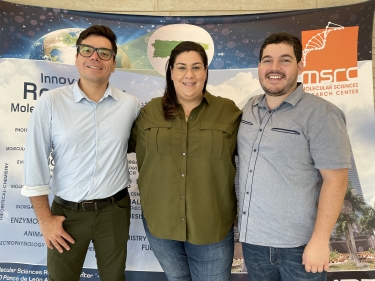ESTUDIANTES INVESTIGADORES DE “EL MOLECULAR” VIAJAN A PRESTIGIOSO LABORATORIO EN NUEVA YORK PARA HACER INVESTIGACIONES BIOMÉDICAS Y EN BATERÍAS
Submitted on 4 December 2023 - 11:50am
This article is reproduced by CienciaPR with permission from the original source.
CienciaPR Contribution:
Original Source:

Alexis G. Lavín Flores, Keyla A. López Pérez and Nataniel Medina Berríos, all student researchers at the UPR Center for Research in Molecular Sciences (CICiM), under the mentorship of Dr. Gerardo Morell and Dr. Brad Weiner, traveled to the prestigious Brookhaven National Laboratory in Long Island, New York, as part of their graduate studies in chemistry.
The trip allowed them to not only learn about what is being done at this respected facility, but to use instruments at the Center for Functional Nanomaterials (CNF). "We will go to conduct tests to describe the properties of nanomaterials that we have made at CICiM with biomedical and energy storage device applications," shared Keyla Lopez.
This scientific journey is a relevant part in the thesis projects of these young people and in the conquest of their doctoral degree, under the Chemistry Graduate Program of the UPR-Río Piedras. "We work on biomedical applications and energy storage devices, two areas of interest and development for science in Puerto Rico, the United States and the world," explained Nataniel Medina.
"In biomedical research we use carbon-based nanoparticles so that drugs that are difficult to mix in water can do so, and iron nanoparticles are used as a contrast agent in magnetic resonance imaging (MRI). In energy storage devices our lab has a variety of research, however, in this case, the focus is on lithium-sulfur batteries, we are looking to increase capacity and improve battery lifetime by controlling the intermediate species formed in the charge and discharge process," he added.
In fact, this team's biomedical project has produced a provisional patent for the solubilization of hydrophobic drugs, i.e., those that do not mix in water.
The results of this study were so positive that when they showed it to the LNB, they opened the doors for a two-year collaboration, through a proposal, through the Molecular Center of the UPR. This is why it is crucial to have access to the instrumentation that only Brookhaven National Laboratory (BNL) can provide.
Regarding the importance of this expedition, Alexis G. Lavín indicated that "in summary, this trip will allow us to know what they look like at the nanometer (nm) level and how the elements are arranged in the materials that we have prepared at CICiM. In addition to gaining experience in instrumentation not available in Puerto Rico at the moment".
"The CICiM facilitates interdisciplinary collaboration that allows us to develop new technologies for biomedical applications, which will benefit the health of the people and the economic growth of Puerto Rico. It also opened the door for the approval of the collaborative proposal with Brookhaven National Laboratory in New York that provides access to our students to use world-class instrumentation in the development of their projects," said Dr. Gerardo Morell, chemist/physicist, professor of the Department of Physics at UPR-Río Piedras, and director of the Puerto Rico NASA Space Grant Consortium and PR NASA EPSCoR Program.
The students have been able to make this trip with grants from various programs, their sponsors have been NASA EPSCoR (Alexis), NASA PR-SPRinT (Keyla) and the NIH-RISE Graduate Program (Nataniel).
The significance of this trip and the awesomeness of "nano".
Brookhaven National Laboratory (LNB) and the Center for Functional Nanomaterials (CFN) have state-of-the-art facilities and equipment. Alexis G. Lavin mentioned, specifically, that they have electron microscopy equipment that allows studies of materials at nanometer scales (0.1 nm).
"To put in context," he explained, "a human hair has a diameter of approximately 80,000 to 100,000 nanometers, i.e., the capacity of this equipment allows us to observe materials a million times smaller. Our team designs and studies materials at this scale with diverse biomedical and energy storage device applications. Having access to these facilities allows us to validate and optimize our synthesis processes and make our nanomaterials more efficient."
"Currently, in biomedical applications, in our lab we are investigating carbon and iron oxide-based materials with the aim of using them as cancer therapy and diagnostic agents. With high-resolution transmission microscopy we can identify the morphology, purity and elemental distribution of these nanomaterials in the materials, essential parameters for future applications," said Lavín.







